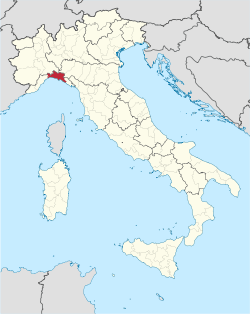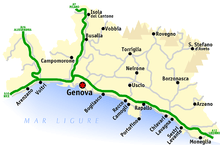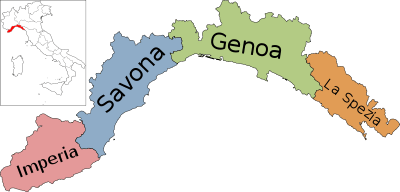Province of Genoa
The Province of Genoa (Italian Provincia di Genova) was a province in the Liguria region of Italy. Its capital was the city of Genoa. It was replaced by Metropolitan City of Genoa.
Province of Genoa | |
|---|---|
Province (1859–2014) | |
 Coat of arms | |
 Map highlighting the location of the province of Genoa in Italy | |
| Country | |
| Region | Liguria |
| Capital(s) | Genoa |
| Comuni | 67 |
| Government | |
| • President | office abolished |
| Area | |
| • Total | 1,838 km2 (710 sq mi) |
| Population (03-31-2012) | |
| • Total | 880,361 |
| • Density | 480/km2 (1,200/sq mi) |
| Time zone | UTC+1 (CET) |
| • Summer (DST) | UTC+2 (CEST) |
| Postal code | 16010 - 16049, 16100 |
| Telephone prefix | 010, 0185 |
| Vehicle registration | GE |
| ISTAT | 010 |
Overview

It has an area of 1,838 square kilometres (710 sq mi) and a total population of about 0.9 million (2009). There are 67 communes in the Metropolitan City of Genoa.
Named after a mythical two-headed Greek God, Janus, protector of ships. The name derives from a Ligurian tribal word, for "knee" (genu), or the Latin name for gate, "janua". The city is set at the foot of mountains in the Gulf of Genoa at the most northerly end of the Tyrrhenian Sea, where at one time it ruled the maritime world. Genoa has fine examples of Baroque Church and Palace architecture.
History
Genoa had been an independent republic for many years, and when Napoleon became Emperor and King of Italy in 1800, it became part of the French Empire. When Napoleon was defeated in 1814, it became part of the Kingdom of Sardinia. At that time Genoa was the most important port and trading center in Italy.[1]
The Province of Genoa was established in 1859 by decree and was established on 1 March 1860. The first chairman was Antonio Caveri, a lawyer. It was subdivided into five districts, Levante, Chiavari, Genoa, Savona, and Albenga, which largely corresponded to previous divisions of the Republic of Genoa, which had broken up after Napoleon's Italian campaign. King Vittorio Emanuele II approved the province's coat of arms in 1875 and they were amended in 1933 by the Fascist Government by the addition of fasces.[2]
Municipalities
- Most populated municipalities
Below is a list of the ten municipalities of the province sorted by number of inhabitants at 31 December 2010:[3]
| Pos. | City | Population (ab) |
|---|---|---|
| 1º | Genova | 607.906 |
| 2º | Rapallo | 30.785 |
| 3º | Chiavari | 27.815 |
| 4º | Sestri Levante | 18.794 |
| 5º | Lavagna | 13.013 |
| 6º | Arenzano | 11.724 |
| 7º | Recco | 10.178 |
| 8º | Santa Margherita Ligure | 9.915 |
| 9º | Cogoleto | 9.209 |
| 10º | Serra Riccò | 7.994 |
See also
References
- Dino Cinel (1 January 1982). From Italy to San Francisco: The Immigrant Experience. Stanford University Press. pp. 22–23. ISBN 978-0-8047-1117-3.
- P. Cavanna, P. Loss, M. Boccaccio, B. Cervetto, M. Fantoni, G. Isola, R. Olivieri (1980). "Storia della Provincia di Genova". Brevi cenni sulla storia dell’Ente Provincia (in Italian). Archived from the original on 2006-05-11. Retrieved 2015-08-05.CS1 maint: uses authors parameter (link)
- http://demo.istat.it/bil2010/index.html
